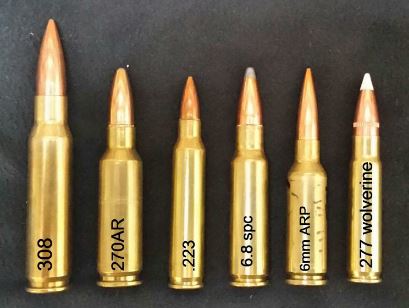.277 Wolverine

The .277 Wolverine (6.8×39mm) is a wildcat cartridge based on the 5.56x45mm NATO round and was designed by Mark Kexel of Mad Dog Weapon Systems in 2014. It is a versatile mid-powered cartridge with better ballistic performance over the AR-15's traditional .223 Remington / 5.56×45mm NATO chamberings. Converting from .223 / 5.56 to the .277 Wolverine requires only a new barrel. It utilizes small rifle primers, as well as .277 caliber projectiles (like the similar 6.8 SPC, the .270 Winchester, as well as the highly anticipated .27 Nosler and .277 Fury).
One major difference between the .277 Wolverine and cartridges such as the 6.5 Grendel or 6.8 SPC, is that the Wolverine is directly based on the 5.56 cartridge and is merely necked up to accept a larger caliber bullet. This is the same design philosophy used on rounds like the .300 Whisper and .300 Blackout. As a result, the round can feed from a standard AR-15 / STANAG magazine. It also means that magazine capacity is not hindered in any way.
Design
For similar reasons that a .277 inch (7.04 mm) diameter bullet was selected for the 6.8 SPC (ideal mass-to-diameter-to-length for mid-weight bullets constrained to loading in an AR-15/M16 STANAG magazine), 6.8mm became the caliber for this new AR-15 wildcat cartridge. Like the .300 AAC Blackout and unlike the 6.8 SPC and other "larger bore" AR-15 cartridges, the .277 Wolverine is based on the widely available 5.56×45mm parent case. Therefore, rifle components such as the bolt and magazine are fully interchangeable between 5.56×45mm and .277 Wolverine firearms, and AR-15 magazines can be used with zero loss in capacity. Overall, a new barrel is the main component needed to be changed in order to convert a standard AR-15 to .277 Wolverine.
To load heavier (longer) bullets to magazine length without problems seating the bullet's ogive into the case mouth, the Wolverine case is shortened to approximately 39 mm from its 45 mm parent brass. The case is resized and formed in a single operation to create a new 23-degree shoulder and a larger neck.
The initial design focused on optimal performance with supersonic bullets in the 85-115 gr (5.5-7.5 g) weight class. As a result, a 1:11 twist rate barrel with 5R Rifling was initially selected. Subsequent consumer interest in firing "heavy-for-caliber" subsonic bullets led to the design, testing, and production of 1:7 twist barrels in order to stabilize the longer and heavier projectiles.